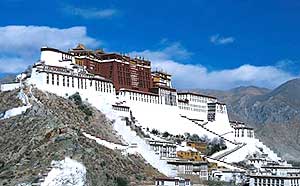Tibetan holy site sends the spirit soaring
Phayul (Source: usatoday.com), November 9, 2006
Lhasa, Tibet -- One is a palace whose godking has fled. The other a temple — dark, smoky and sticky underfoot. Each visible from the roof of the other, and both located on the very roof of the world, together they form a dramatic double act of spiritual power, architectural splendor and faith enduring against all odds.
 << Potala Palace
<< Potala Palace
The breathtaking Potala Palace and Jokhang Temple, chosen by our panel of experts as one of the seven New Wonders of the World, pierce the heart of Tibet's capital of Lhasa. Together, they have filled visitors with awe for centuries — and still do, despite the tragedy of modern politics.
As some of the most intense spiritual monuments in the world, says panelist and author Pico Iyer, they are still among the last replicas of old Tibet.
Consider the Tibetan Buddhist pilgrims for whom Lhasa truly is the holy grail. To get here, some have prostrated themselves on the ground, one step at a time, for hundreds of miles, to show devotion and earn merit for the next life — or simply better luck in this one.
Perched serenely on a hill above the modern clutter of an ever-more Chinese city, the red and white Potala dominates the Lhasa River valley. With 7th-century origins, the present structure was built in the 17th century by the Great Fifth Dalai Lama, Tibet's spiritual and temporal ruler.
Within its 13 stories and thousand rooms lie the remains of several Dalai Lamas and a feast of art and statuary from Lamaism, Tibet's mystical development of Indian Buddhism. It is a labyrinth of creaking staircases and dark chapels, where pilgrims place ceremonial white scarves and pour libations of yak butter or oil.
The Potala's last resident, the 14th Dalai Lama, Tenzin Gyatso, fled Chairman Mao's troops in 1959 amid a failed uprising and has remained in exile in India ever since.
While the Potala has a museum - like feel, the Jokhang Temple, about a mile to the east, lives and breathes. There you rub shoulders with people from the farthest reaches of Tibet, Iyer says. You see faces that have come out of the 13th century . . . in a place that's all flickering candles and barely discerned statues and alive with the spirits of old Lhasa.
The holiest of holies, the 7th century Jokhang is the most revered site in Tibet. The proof lies in the forecourt, where the paving stones are worn smooth by the prostration of pilgrims from dawn to dusk.
Inside lies a warren of chapels and Buddhist images. The floor is sticky from the yak butter offerings of Tibetan pilgrims, who murmur prayers as they circle, turning prayer wheels as they go.
Up on the roof, framed by the vast sky and the mountains that hem in Lhasa, younger maroonrobed monks are put through their theological paces in lively one-on-one bouts amid swelling crowds of Chinese tourists, who have doubled in number since the arrival of the new Lhasa train in July from four cities in China.
As long as the Jokhang survives the new onslaught of visitors, Iyer says, something important in Tibetan culture will survive.

 << Potala Palace
<< Potala Palace